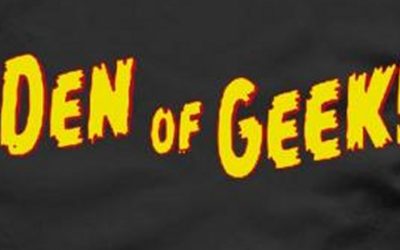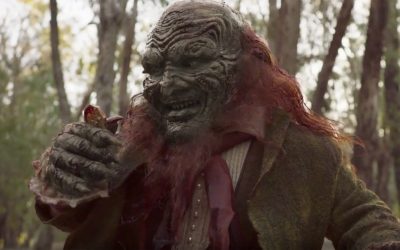
Sweet Tooth TV show in the works
Jeff Lemire’s Sweet Tooth will be adapted for TV by Hulu and Robert Downey Jr.’s production company…
Jeff Lemire’s weird, post-apocalyptic coming of age comic Sweet Tooth is coming to television.
The comic series just received a pilot order from Hulu. According to Deadline, Sweet Tooth is being produced by Robert Downey, Jr.’s production company in conjunction with Warner Brothers and Jim Mickle, who brought Joe Lansdale’s Hap And Leonard to the screen (which we miss terribly).
The story follows Gus, a 9 year old half boy half deer, as he ventures out into the world following an unknown apocalypse. Gus has been raised by a deeply religious survivalist father. He eventually falls in with a group of humans and hybrids and heads out on a quest that reveals some interesting information about the world they inhabit.
The comic ran for 40 issues and was written and drawn by Lemire, a talented creator who has very particular sensibilities. Some of his work is quiet, personal and weird, like The Underwater Welder or Essex County. And some of his work is quiet, personal, weird and also popular mainstream superhero comics, like The Terrifics or The Sentry or Black Hammer. Sweet Tooth is more of the former, like if Cormac McCarthy had been born in a Toronto suburb. When he draws his own books, Lemire tends towards a looser, cartoony line that looks more like polished sketchwork than traditional superhero art. However, here in Sweet Tooth, it meets those two styles in the middle – you get a ghost of Lemire’s hard-indie roots and exaggerated cartooning, with a harder edge to the design work like early Phil Hester. It’s really distinctive, and hopefully the television show manages to find a way to translate that sensibility.
Sweet Tooth is the fifth Vertigo property heading to small screens, following iZombie, Preacher, Lucifer and Survivor’s Club (and Watchmen depending on how you count Vertigo).
More as we get it.
Clique season 2 episode 2 review
Caroline Preece
Nov 19, 2018
Clique series two is proving compelling viewing. Spoilers ahead in our episode two review…
This review contains spoilers. See related
Clique series 2 episode…
Doctor Who’s sonic screwdriver: how much is too much?
It’s a Doctor’s best friend. But do some Doctor Who plots rely too heavily on the sonic screwdriver? Zoe dismantles the gadget…
Modern technology isn’t all it’s made out to be: in Demons Of The Punjab, we saw the sonic screwdriver break for the second time in a row. The previous week, the Ptinga made a tasty meal out of the trusty device, though of course, it couldn’t stay away for long. As the Doctor brightly informed us, the sonic screwdriver now has a reboot setting. It was a weak moment in an otherwise tightly plotted episode, but then, consistency is not necessarily a requirement in Doctor Who. The polarity of the neutron flow can be reversed as many times as the writers please… so long as it’s in service to the plot. But Doctor Who has been oppressed by the sonic screwdriver now for quite some time. Once merely convenient, the shrieking metal stick has become indispensable.
The Woman Who Fell To Earth teased us with the bold decision to present the Doctor without her gear – no TARDIS, no screwdriver. The choice spoke to the vast potential series eleven has to chart its own path, brushing away the cobwebs of accumulated history. But this opened space didn’t last. By the episode’s midway point, the Doctor had already built herself a new sonic, and the TARDIS appeared on cue in the second episode.
It might seem inconceivable to imagine the Doctor without these familiar apparatus, but it’s not unprecedented. The Pertwee era began with a similarly bold move – grounding the Doctor on planet earth, with his ability to pilot the TARDIS removed and his access to non-Earth technology minuscule. Here, though, the third Doctor’s writing team stuck with their premise. We watch the Doctor navigate mundane earth life, worse, military life, and learn who he is without his toys. The upshot: still a hero, albeit a crankier one.
During the Tom Baker era, the series found itself laden with another deus-ex-machina device. K9, everyone’s favorite robo-dog. K9 was a lovable bantering partner, with access to a vast data-bank and, more pertinent, a laser ray gun, but at some point audience and writers grew sick of every tense encounter ending with K9’s intervention. The writers bit the bullet and wrote the dog out.
There are, of course, solid and functional writing reasons for the sonic screwdriver’s ubiquity. In Classic Who, the Doctor was free to spend precious minutes occupied by mundane problems like getting out of locked cells and obtaining information from reluctant officials. But NuWho‘s Doctor simply doesn’t have the time. A quick buzz of the sonic screwdriver and the door clicks open, the computer reveals its secrets, and the dreaded filler has been successfully circumnavigated. At this point in NuWho‘s run, though, it’s worth asking whether this convenience has come with a cost. Has the Doctor become nothing more than a techno-wizard, solving problems with a flick of her wand? Isn’t what we love and look to most in Doctor Who the Doctor’s willingness to engage and question?
In The Tsuangra Conundrum, the Doctor paces down the undifferentiated white corridors, in search of information. She ignores the medic Astos’ attempts to engage her in conversation, instead aiming her screwdriver over his head, and reading the computers herself. It’s a simple moment, easy to lose in the pace of the narrative, but for me it was a telling one. We’ve lost something, if the Doctor is no longer the person asking questions, rather than reading answers from the narrow edge of her screwdriver, when the Doctor no longer needs to engage with the minor characters populating each episode’s quickly constructed world. On the level of plot construction, the sonic screwdriver allows the writers to bypass engagement between the Doctor and the other characters until their requisite ‘character moments’. The effect becomes one of clunky, telegraphed characterisation, lacking organic verve.
This problem – and its potential solution – was very much on display in last weekend’s episode, Demons Of The Punjab. In the first half of the episode, it’s hard to hear anything over the sonic screwdriver’s constant shrilling. When the Doctor and co are dropped into the alien’s mysterious lair, the Doctor once again chooses to read the answers off a screen, rather than asking questions of the aliens themselves. Instead of discourse, there’s metallic buzzing.
It’s not until the sonic screwdriver breaks that the real plot can get underway. Without the sonic screwdriver to manufacture technical deus-ex-machinas, the Doctor is forced into actual conversation with the Thijarians, and from this learns their true nature – not deadly assassins, but benevolent witnesses. The moment of revelation is powerful, but it’s hard to ignore that it only was made possible by the show’s habitual dependence on the sonic screwdriver to give quick answers and last-minute escapes.
The fundamental problem faced by NuWho is still its punishing time limit, the set fifty minutes in which the Doctor must enter a new situation, uncover a problem, be in grave danger, escape grave danger, and save the day, hopefully with character development thrown in. Moffat chose to address this problem through increasingly convoluted season arcs, with re-occurring characters and two-parters. Chibnall, who has vowed to do away with all old villains and abstain from two-parters, has left the show in a self-created bind – series eleven has committed to prioritising characterisation, but meaningful characterisation can’t be streamlined.
Demons Of The Punjab more than any other episode so far in the season has succeeded at drawing organic, nuanced character portraits of minor characters. Prem doesn’t merely shine at his moment of sacrifice – his humanity, compassion, and personal tragedy are on display throughout the whole episode, building brilliantly to the powerful finish. His brother, Manish, managed to bring some complexity and empathy that’s been lacking in the season’s other antagonists. The characterisation succeeds because it is given space to breathe.
There’s a lesson in Demons Of The Punjab, if the show is willing to heed it. Silence the sonic screwdriver. And let the characters speak.
Supernatural season 14 episode 6 review: Optimism
Bridget LaMonica
Nov 16, 2018
A decidedly more chipper episode of Supernatural includes a zombie boyfriend and a bug monster…
This review contains spoilers. See related
Supernatural sea…
Fantastic Beasts 2: who is Nagini and how does she fit into the Wizarding World?
Caroline Preece
Nov 17, 2018
We look back at the role Nagini has played in the Potterverse so far, and delve into her story in prequel The Crimes Of Grindelwald…
Warning: contains spoilers for Fantastic Beasts…
PlayStation: Sony will not attend E3 2019
Sony are skipping E3 for the first time in the event’s history
In a somewhat surprising move, Sony has announced that they are skipping E3 2019.
“As the industry evolves, Sony Interactive Entertainment continues to look for inventive opportunities to engage the community,” said Sony in a statement to Game Informer. “PlayStation fans mean the world to us and we always want to innovate, think differently and experiment with new ways to delight gamers. As a result, we have decided not to participate in E3 in 2019.”
Sony also stated that they are exploring “new and familiar ways to engage our community in 2019 and can’t wait to share our plans.”
The idea of Sony not being at E3 is certainly odd. Not only is the first E3 ever that they will not attend, but Sony is responsible for some of the greatest highlights in the show’s history. Indeed, their recent press conferences have generally been seen as the gold standard of E3 presentations. Of course, not everyone was on-board with their elaborate (but tedious) multi-stage set-up at E3 2018.
Interestingly, that presentation may have been the key factor in Sony’s decision to skip E3 2019. It was clear that Sony was thinking beyond the limits of the E3 event and perhaps even beyond the limits of their own shows (remember that they’ve canceled this year’s PlayStation Experience event). Of course, that does raise some questions regarding what Sony will replace these events with. The obvious answer is that they will run a single event that may even run against (or around the same time of) E3. We’d be shocked if Sony skips events altogether.
However, we wouldn’t be shocked if Sony goes the Nintendo route and starts hosting Direct-style announcements online either. Not only are such announcements cheaper and arguably further reaching, but they have the added benefit of being extremely controlled. In other words, they’re free of any live presentation errors. It’s also possible that this decision has something to do with them wanting to have as much control over the PS5’s reveal as possible.
It’s also worth noting that Microsoft has taken this opportunity to announce they will still host an E3 2019 conference. Suffice to say, they’ll be drawing a lot of extra attention at next year’s show.
Geeks Vs Loneliness: steal a day
Jane Roberts
Nov 23, 2018
A few words this week on the importance of taking some time for you and shaking up your routine…
Hello and welcome to Geeks Vs Loneliness, our regular spot to drop in, say hello and …
Geeks Vs Loneliness: steal a day
Jane Roberts
Nov 23, 2018
A few words this week on the importance of taking some time for you and shaking up your routine…
Hello and welcome to Geeks Vs Loneliness, our regular spot to drop in, say hello and …
First trailer for Leprechaun Returns
Paul Bradshaw
Nov 16, 2018
Stop giggling…
This year’s Halloween reboot proved that audiences still have an appetite for decent, serious attempts to resurrect classic horror franchises. In completely unrelated…
The Little Drummer Girl episode 4 review
Louisa Mellor
Nov 19, 2018
The threat becomes real for Charlie as Marty’s plan enters its next phase. Spoilers ahead in our review…
This review contains spoilers. See related
The Last King…









